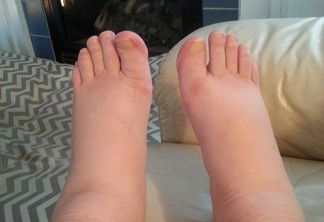A blood clot, although typically a normal repair process, can pose risks when formed unnecessarily. Recognizing vital warning signs is crucial. We will highlight key indicators of a blood clot, including the significance of blood flow and the prevention of its formation.
1. Swelling

Swelling in the arms or legs may indicate the presence of a deep vein thrombosis or DVT. Factors like recent surgery, immobility, or extended air travel increase the risk of DVT.
2. Color Change/ Red Streak

The presence of itching, redness, blueness, or a red streak in a specific body area could indicate the potential presence of a blood clot. These color changes often signify tenderness and swelling in the affected region.
3. Pain

When circulation to your limbs is obstructed by a blood clot, it can result in inflammation, causing intense pain in the affected limb.
4. Breathing Issues

If it has traveled to your lungs, it can lead to a severe cough, coughing up blood, chest pain, and dizziness. Seek immediate medical attention in such cases!
5. Racing Heart

A blood clot in your lungs slows O2 flow, prompting your heart rate to accelerate compensatorily.
6. Speech or Vision Issues

The presence of fatty deposits in blood vessel walls can lead to a brain blood clot, resulting in issues such as vision/speech problems, seizures, and weakness.
7. Nausea or Vomiting

When it forms in the veins draining the intestines, it can lead to symptoms such as stomach pain, nausea, vomiting, diarrhea, and blood in the stool.
8. High Blood Pressure

A blood clot in the kidneys hampers waste removal, leading to kidney failure, and high blood pressure. Symptoms include fever, blood in urine, breathing difficulties, and sudden leg swelling.
Did you know these warning signs? Do you know someone who suffers from it? Share your thoughts below in the comments.
